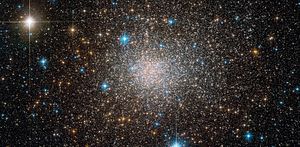Terzan 5
| Terzan 5 | |
|---|---|

Hubble image of Terzan 5
Credit: NASA/ESA/Hubble/F. Ferraro |
|
| Observation data (J2000 epoch) | |
| Class | G2 |
| Constellation | Sagittarius |
| Right ascension | 17h 48m 05s |
| Declination | −24° 46′ 48″ |
| Distance | 18.8 ± 1.6 kly (5.9 ± 0.5 kpc) |
| Apparent magnitude (V) | 12.8 |
| Apparent dimensions (V) | 1′02″ (half-mass diameter) |
| Physical characteristics | |
| Mass | ~2×106 M☉ (4 × 1036 kg) |
| Radius | 2.7 ly |
| VHB | 22.5 |
| Metallicity | = −0.21 dex |
| Estimated age | 12 Gyr |
| Notable features | Possibly the core of a disrupted dwarf galaxy |
| Other designations | Ter 5, IRC–20385 |
Terzan 5 is a heavily obscured globular cluster belonging to the bulge (the central star concentration) of the Milky Way galaxy. It was one of six globulars discovered by French astronomer Agop Terzan in 1968 and was initially labeled Terzan 11. The cluster was cataloged by the Two-Micron Sky Survey as IRC–20385. It is situated in the Sagittarius constellation in the direction of the Milky Way's center. Terzan 5 probably follows an unknown complicated orbit around the center of the galaxy, but currently it is moving towards the Sun with a speed of around 90 km/s.
The absolute magnitude of Terzan 5 is at least MV=−7.5. The total bolometric luminosity of it is about 800,000 times more than that of the Sun, while its mass is about 2 million Sun's masses. The small core of Terzan 5—about 0.5 pc in size—has one of the highest star densities in the galaxy. Its volume mass density exceeds 106M☉/pc3, while its volume luminosity density exceeds 105.5L☉/pc3, where M☉ and L☉ are the Sun's mass and luminosity, respectively. The cluster also has one of the highest metallicities among Milky Way's globular clusters—[Fe/H]=−0.21.
In 2009 it was discovered that Terzan 5 consists of at least two generations of stars with ages of 12 and 4.5 billion years and slightly different metallicities, possibly indicating that it is the core of a disrupted dwarf galaxy, not a true globular cluster. There are only a few other globular clusters in Milky Way that contain stars with different ages. Among them are M54 and Omega Centauri. The cluster also contains around 1300 core helium burning horizontal branch (HB) stars, including at least one RR Lyrae variable star.
...
Wikipedia

![{\displaystyle {\begin{smallmatrix}\left[{\ce {Fe}}/{\ce {H}}\right]\end{smallmatrix}}}](https://wikimedia.org/api/rest_v1/media/math/render/svg/4c0821bd80891e071c08e7c7ee8e022baedf522c)